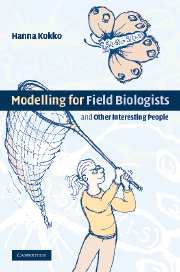Book contents
- Frontmatter
- Contents
- Preface
- 1 Modelling philosophy
- 2 Population genetics
- 3 Quantitative genetics
- 4 Optimization methods
- 5 Dynamic optimization
- 6 Game theory
- 7 Self-consistent games and evolutionary invasion analysis
- 8 Individual-based simulations
- 9 Concluding remarks
- Appendix: A quick guide to MATLAB
- References
- Index
1 - Modelling philosophy
Published online by Cambridge University Press: 05 June 2012
- Frontmatter
- Contents
- Preface
- 1 Modelling philosophy
- 2 Population genetics
- 3 Quantitative genetics
- 4 Optimization methods
- 5 Dynamic optimization
- 6 Game theory
- 7 Self-consistent games and evolutionary invasion analysis
- 8 Individual-based simulations
- 9 Concluding remarks
- Appendix: A quick guide to MATLAB
- References
- Index
Summary
where we get momentarily lost in a forest, but emerge intact
Figure 1.1 shows three different kinds of model. A supermodel like Naomi Campbell presents, to some of us at least, an ‘idealized’ concept of a human being (Fig. 1.1a). The miniature model shown in Fig. 1.1b was built by my uncle to show what his home town Kuopio looked like in the 1930s. Finally, Fig. 1.1c is a mathematical description of the dynamics of a two-species system of a predator and a prey species.
The models all look very different. They also differ a lot in how scary they look to the average behavioural or evolutionary ecologist – most will have to resist the temptation to close their eyes when encountering Fig. 1.1c, together with its equations, much more than when looking at Fig. 1.1a. My aim in this chapter is to show that there is indeed a reason why the word ‘model’ is used to describe all these figures, to rectify some common misconceptions about models (especially the mathematical ones), and to make life a little less scary for those who know they should be more familiar with modelling in behavioural or evolutionary ecology than they currently are.
Ecology is defined as a science that investigates the abundance and distribution of organisms. This may first sound a little boring, but it gets more interesting once one notices that interactions between organisms play a crucial role here.
Information
- Type
- Chapter
- Information
- Publisher: Cambridge University PressPrint publication year: 2007
Accessibility standard: Unknown
Why this information is here
This section outlines the accessibility features of this content - including support for screen readers, full keyboard navigation and high-contrast display options. This may not be relevant for you.Accessibility Information
- 1
- Cited by
